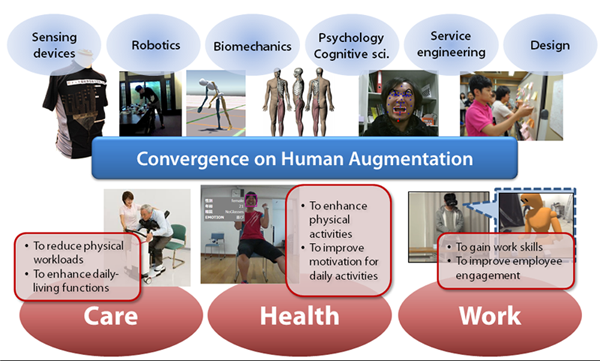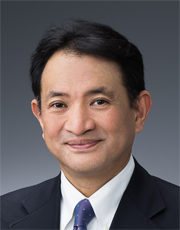Year of 2024
- pubilication date
-
contents
- Dec.6
-
Dec.3
Best Poster Award:
J.Ohyama, M.Otsuki, H.Tanaka, K.Watanabe, S.Meguro, S.Miura, I.Hisanaga, K.Isoda, A.Matsuyama, M.Tanaka, S.Niida, N.Tojo, H.Kawanishi, Y.Miura, T.Miyake and M.Mochimaru:
"Evaluation of a Concept of Developing Daily Experience Database Using Virtual Proof-of-Concept Experiment in Shopping Use Case",
ICAT-EGVE 2024 - Oct. 11
- Oct. 8
ISWC 20-year Impact Award:
T. Kurata, N. Sakata, M. Kourogi, H. Kuzuoka and M. Billinghurst:
"Remote collaboration using a shoulder-worn active camera/laser",
Eighth International Symposium on Wearable Computers, pp. 62-69, ISWC 2004 doi: 10.1109/ISWC.2004.37. - Oct. 4
-
Sep. 26
Best paper award:
Fumiya Akasaka, Hiroko Akiyama, Mika Yasuoka, Momoko Nakatani, Ryuichi Nambu:
"Platform-level Living Lab Canvas: a tool to support the sustainable management of living labs for social transformation",
Open Living Lab Days Conference 2024 (OLLD2024)
Year of 2023
- pubilication date
-
contents
- Jan. 23
-
Jan. 20
Best Paper Award Finalist:
Satoki Ogiso, Yoshiaki Bando, Takeshi Kurata, Takashi Okuma:
"Infrastructure-Less Localization from Indoor Environmental Sounds Based on Spectral Decomposition and Spatial Likelihood Model",
The 2023 IEEE/SICE International Symposium on System Integrations (SII 2023), Atlanta, USA
Year of 2022
- pubilication date
-
contents
- Jul. 15
-
Jun. 29
Best poster award:
Tzu-Yang Wang, Mai Otsuki and Hideaki Kuzuoka:
"Evaluating Workload in One-to-Many Remote Collaboration.",
PETRA 2022, Corfu, Greece, - Jun. 27
- Jun. 26
Best paper award:
Ryo Hanashima, Junji Ohyama:
"How to Elicit Ownership and Agency for an Avatar Presented in the Third-Person Perspective: The Effect of Visuo-Motor and Tactile Feedback",
HCI International (HCII) 2022 Human Interface and the Management of Information (HIMI) Thematic Area - Feb. 14
- The Role of Art in Advanced Technology
Datetime: 18 February 2022 - 9.00 - 12.45 (CET) | 17.00 - 20.45 (JST)
Online - In English
Programme - Feb. 1
-
Jan. 31
Wakako Tsuchida, Yoshiyuki Kobayashi, Koh Inoue, Masanori Horie, Kumiko Yoshihara, Toshihiko Ooie:
"Kinematic characteristics during gait in frail older women identified by principal component analysis" ,
Scientific Reports - Jan. 28
-
Jan. 27
Gaku Kutsuzawa, Hiroyuki Umemura, Koichiro Eto, Yoshiyuki Kobayashi:
"Classification of 74 facial emoji’s emotional states on the valence-arousal axes",
Scientific Reports
Human augmentation is a system to be attached to human, in order to enhance and empower human functions. With a broad sense, microscopes and telescopes are a part of human augmentation technologies, whereas Human Augmentation Research Center (HARC) focuses on a wearable and/or invisible system based on information-communication technologies and robotic technologies.
Using human augmentation system, human functions are enhanced and empowered temporarily. Moreover, we aim for researches to augment biological human functions through a long period use of the system. HARC challenges to launch a new industry based on human augmentation technologies towards "Society 5.0."
Namely, the mission of HARC is to develop human augmentation technologies for maintenance and enhancement of human functions (physical, emotional and communicational functions), improvement quality of life, reduction of social costs and development of industries (knowledge intensive business services relevant to daily living). The following inter-disciplinary researchers joined to HARC to carry out the mission; flexible sensing technologies, robotics, biomechanics, ergonomics, psychology, service engineering and design.
HARC is located at AIST Kashiwa Center (c/o Kashiwa II Campus, University of Tokyo). We cooperate closely with University of Tokyo, Chiba University and National Cancer Center Japan that are located in Kashiwanoha. Here, Kashiwanoha region is a newly developed town including residential areas and shopping malls. HARC is pushing through social implementation of new service businesses based on human augmentation technologies through enlisting cooperation with residents in Kashiwanoha and a real estate company that developed Kashiwanoha.







